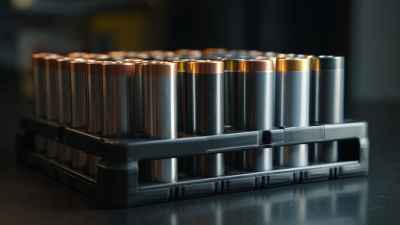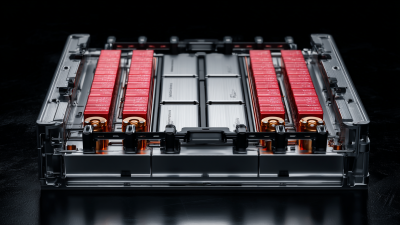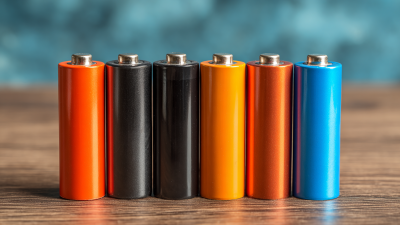How to Choose the Right Rack Mount Lifepo4 Battery for Your Needs
Table of Contents
- Understanding Lifepo4 Battery Basics and Its Advantages
- Key Specifications to Consider When Choosing Rack Mount Lifepo4 Batteries
- Evaluating Energy Capacity and Power Output for Your Application
- Assessing Cycle Life and Durability of Lifepo4 Batteries
- Importance of Safety Features in Lifepo4 Battery Selection
- Comparing Cost-Effectiveness of Lifepo4 vs. Other Battery Technologies
- FAQS
- Conclusion
- Related Posts
In today's rapidly evolving energy landscape, selecting the appropriate Rack Mount Lifepo4 Battery is crucial for both efficiency and sustainability. With Roofer Electronics Technology (Shanwei) Co., Ltd. boasting over 27 years of expertise in R&D, manufacturing, and solutions for lithium batteries, our commitment to advancing energy storage systems is unwavering. The global lithium-ion battery market is projected to reach $129 billion by 2027, driven by the increasing demand for energy storage in various applications including household energy storage systems, electric vehicles, and renewable energy integration.
 The Rack Mount Lifepo4 Battery, known for its high energy density, longer lifecycle, and enhanced safety features, is particularly gaining traction among industries aiming to reduce reliance on conventional lead-acid batteries. As energy needs become more sophisticated, understanding the specifications and advantages of Rack Mount Lifepo4 Batteries is essential for optimizing performance and achieving energy independence.
The Rack Mount Lifepo4 Battery, known for its high energy density, longer lifecycle, and enhanced safety features, is particularly gaining traction among industries aiming to reduce reliance on conventional lead-acid batteries. As energy needs become more sophisticated, understanding the specifications and advantages of Rack Mount Lifepo4 Batteries is essential for optimizing performance and achieving energy independence.
Understanding Lifepo4 Battery Basics and Its Advantages
Understanding the basics of LiFePO4 (lithium iron phosphate) batteries is essential for anyone looking to incorporate this technology into their energy solutions. Renowned for their safety and thermal stability, LiFePO4 batteries boast a longer lifespan than traditional lithium-ion batteries, with a reported cycle life of over 2,000 cycles. This endurance, coupled with a stable performance, makes them a valuable choice for applications requiring reliability and efficiency, particularly in renewable energy storage systems. Additionally, the global market for LiFePO4 batteries is projected to surpass $17.08 billion by 2025, growing at a compound annual growth rate of 17.3%, driven by increasing demand for sustainable energy solutions.
As advancements in battery technology continue, competition intensifies, with solid-state batteries emerging as a potential game-changer. However, LiFePO4 batteries still hold significant advantages, notably their ability to deliver consistent power without the risk of thermal runaway. Recent innovations are also addressing performance shortcomings, such as improving energy density through enhanced battery designs. This potential for further optimization underscores the importance of understanding LiFePO4 batteries' role not only within current market dynamics but also in the evolving landscape of energy storage technology.

Key Specifications to Consider When Choosing Rack Mount Lifepo4 Batteries
When selecting a rack mount LiFePO4 battery, key specifications must be considered to ensure it meets your specific needs. First, assess the battery's capacity measured in amp-hours (Ah), as this will determine how long it can power your devices. Higher capacity batteries are generally preferred for applications requiring extended runtimes, while smaller capacities may suffice for lighter loads. Additionally, examine the discharge rate, which indicates how quickly the battery can supply power. A higher rate is critical for devices that demand a significant amount of energy in short bursts.
Another important factor is the battery's dimensions and weight, which can affect installation and portability. Ensure that the size fits your rack space while also considering the weight, as heavier batteries may require sturdier support. Finally, look into the battery's cycle life and warranty terms; a longer cycle life indicates better longevity and lower replacement costs over time. By prioritizing these specifications, you can choose a rack mount LiFePO4 battery that reliably meets your needs and prevents disruptions in power during outages.
How to Choose the Right Rack Mount Lifepo4 Battery for Your Needs
| Specification | Description | Importance |
|---|---|---|
| Capacity | Measured in ampere-hours (Ah), indicates how much energy the battery can store. | Critical for determining how long the battery can power your equipment. |
| Voltage | The nominal voltage, typically 12V, 24V, or 48V for rack mount systems. | Essential to match with your system's requirements. |
| Size/Dimensions | Physical dimensions of the battery, important for compatibility with rack space. | Ensures optimal space utilization in your setup. |
| Cycle Life | Number of complete charge-discharge cycles the battery can undergo before capacity significantly drops. | Affects long-term investment and maintenance costs. |
| Discharge Rate | Rate at which the battery can deliver power, measured in C-rate. | Crucial for devices that require high bursts of power. |
| Safety Features | Includes built-in protection against overcharging, overheating, and short circuits. | Important to prevent accidents and prolong battery life. |
| Warranty | Duration and terms of the warranty provided by the manufacturer. | Reflects confidence in product quality and longevity. |
Evaluating Energy Capacity and Power Output for Your Application
When selecting a rack mount LiFePO4 battery, evaluating energy capacity and power output is crucial for ensuring optimal performance in your specific application. Energy capacity, typically measured in kilowatt-hours (kWh), indicates the total amount of energy stored in the battery. A report by the National Renewable Energy Laboratory (NREL) suggests that the ideal energy capacity should align with the daily energy consumption of your system, with a common recommendation being to have a battery capacity that exceeds the daily requirements by at least 20% to account for inefficiencies and potential load peaks.

Power output, on the other hand, is fundamental for understanding how well a battery can handle instantaneous demands. This parameter is often expressed in kilowatts (kW) and is particularly important for applications that involve high surge loads. According to a study by the International Energy Agency (IEA), choosing a battery with a power output capable of meeting at least 1.5 times the peak load of your appliances ensures reliability during peak consumption periods. Balancing these two elements not only maximizes efficiency but also enhances the longevity of your rack mount battery system, providing a more sustainable energy solution tailored to your needs.
Assessing Cycle Life and Durability of Lifepo4 Batteries
When selecting a rack mount LiFePO4 battery, assessing its cycle life and durability is crucial. Cycle life refers to the number of charge and discharge cycles a battery can undergo before its capacity significantly degrades. High-quality LiFePO4 batteries are known for their impressive cycle life, often exceeding 2000 cycles, which translates into several years of reliable service. This extended lifespan reduces the frequency of replacement, ultimately contributing to lower long-term costs and sustainability.
Durability is another key aspect to consider. LiFePO4 batteries boast excellent thermal stability and a robust design, enabling them to withstand various environmental conditions without compromising performance. Factors such as temperature variability, humidity, and vibration can influence battery longevity; therefore, a durable battery will not only ensure consistent energy output but will also survive in demanding settings. Evaluating these attributes will aid in selecting a rack mount LiFePO4 battery that meets your specific energy needs while ensuring a dependable and long-lasting power source.
Cycle Life and Durability Comparison of Lifepo4 Batteries
Importance of Safety Features in Lifepo4 Battery Selection
When selecting a LiFePO4 (Lithium Iron Phosphate) battery for your needs, safety features must be a top priority. LiFePO4 batteries are known for their thermal stability and safety compared to other lithium-ion options, but variations in design and manufacturing can influence safety performance significantly. Key safety features to consider include built-in Battery Management Systems (BMS), which regulate charging and discharging to prevent over-voltage, under-voltage, and short-circuits. A reliable BMS serves as the first line of defense, ensuring that the battery operates within safe parameters, significantly reducing risks associated with battery failure.
Another important consideration is the battery’s certification and compliance with international safety standards. Look for products that have been tested and certified by reputable organizations, as this reflects adherence to established safety protocols. Additionally, check for physical safety features such as thermal fuses and flame-retardant casings. These elements can further protect against accidents related to overheating or external impacts. Prioritizing these safety features not only enhances the lifespan and reliability of the LiFePO4 battery but also ensures the well-being of users and equipment alike.
Comparing Cost-Effectiveness of Lifepo4 vs. Other Battery Technologies
When considering the cost-effectiveness of LiFePO4 batteries compared to other battery technologies, it's essential to evaluate both initial investment and long-term benefits. LiFePO4 batteries typically have a higher upfront cost than lead-acid options. However, their longer lifespan—often exceeding 10 years—can lead to lower overall replacement costs. Additionally, LiFePO4 batteries exhibit superior performance in terms of cycling stability and charge efficiency, meaning they maintain capacity better over time, which translates to further savings in operational costs.
In contrast, while traditional lead-acid batteries may seem more affordable initially, they require more frequent replacements and maintenance. Other advanced battery technologies, such as lithium-ion variants, can offer competitive longevity but might not match the thermal stability and safety that LiFePO4 batteries provide. In terms of total cost of ownership, including maintenance, performance, and operational efficiency, LiFePO4 batteries often emerge as a more economical choice in the long run, making them an attractive option for various applications, especially in rack mount systems.
FAQS
: LiFePO4 batteries are renowned for their safety, thermal stability, and longer lifespan, boasting a cycle life of over 2,000 cycles. They deliver consistent power without the risk of thermal runaway, making them suitable for applications requiring reliability and efficiency.
The global market for LiFePO4 batteries is projected to surpass $17.08 billion by 2025, with a compound annual growth rate of 17.3% driven by increasing demand for sustainable energy solutions.
Key factors include energy capacity and power output. Energy capacity, measured in kilowatt-hours (kWh), should exceed daily consumption by at least 20%. Power output, expressed in kilowatts (kW), should meet at least 1.5 times the peak load of appliances for reliable performance.
A Battery Management System regulates charging and discharging to prevent issues like over-voltage, under-voltage, and short circuits. It serves as a critical safety feature, ensuring that the battery operates within safe parameters.
Important safety features include a reliable Battery Management System (BMS), adherence to international safety standards, thermal fuses, and flame-retardant casings, which help protect against overheating and accidents.
Prioritizing safety features enhances the lifespan and reliability of LiFePO4 batteries by reducing risks associated with battery failure and ensuring user and equipment safety.
The ideal strategy is to select a battery with energy capacity that exceeds daily requirements by at least 20% and a power output that can handle 1.5 times the peak load of appliances, maximizing efficiency and battery longevity.
Recent innovations are addressing performance shortcomings, including enhancements in battery designs to improve energy density, highlighting the ongoing potential for optimizing LiFePO4 technology.
While solid-state batteries are emerging as potential game-changers, LiFePO4 batteries still offer significant advantages such as safety and thermal stability, making them a reliable choice in the current energy storage landscape.
Conclusion
When selecting a Rack Mount Lifepo4 Battery, it’s essential to understand its fundamental characteristics and advantages, including superior energy efficiency and longer lifespan. Key specifications such as energy capacity and power output are critical to ensure the battery meets your specific application needs. Evaluating cycle life and durability will also inform your choice, as these factors impact long-term performance and reliability. Additionally, prioritize safety features to protect both the battery and the equipment it powers.
Cost-effectiveness is another crucial aspect, especially when comparing Lifepo4 with other battery technologies. Roofer Electronics Technology (Shanwei) Co., Ltd., with over 27 years of experience in lithium battery development and manufacturing, offers a variety of solutions tailored to different applications, emphasizing quality and performance in their Rack Mount Lifepo4 Battery offerings. Making an informed decision will lead to optimal energy solutions and better overall efficiency for your needs.
Related Posts
-

How to Optimize Your Lifepo4 Battery Rack for Maximum Efficiency
-

Why Lithium Iron Phosphate Batteries Stand Out Among Other Battery Technologies
-

Advantages of Utilizing Battery Solar Lithium 51.2v Lithium Solar Battery for Sustainable Energy Solutions
-

Leading Global Manufacturer: Explore the Best 3.2v 100ah Lifepo4 Battery Cells Available Today
-

Ultimate Guide to Understanding Lifepo4 Battery Cell Technology and Its Benefits for Modern Energy Solutions
-

Ultimate Guide to Understanding Li Ion Pack Technology and Its Market Potential





 business@roofer.cn
business@roofer.cn +86 13502883088
+86 13502883088






